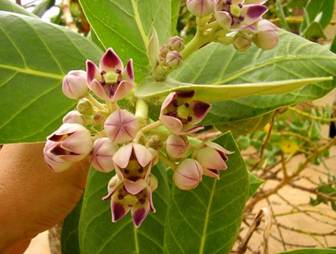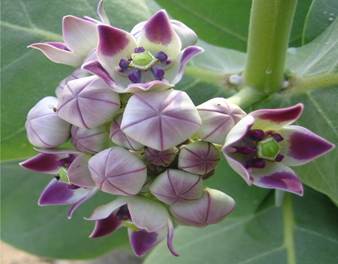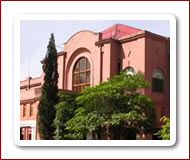|
BOTANICAL NAME:
FAMILY:
SYNONYM(S):
- Caltropis hamiltoni
- Asclepias procera willd
URDU NAME:
REGIONAL NAME:
- Bengali: Akanda
- Punjabi: AK, Shakarallighal, Shakarulushar.
- Persian: Khark
- Hindi: Ag, Ak, Akada, Madar, Safedak
- Pashto: Spalmy
- Sanskrit: Arka
- Sindhi: Ak
- Burma: Myopin
- Arabic: Ochar, Oshar
UNANI/TIBBI NAME:
ENGLISH NAME:
HABITAT:
- It is found in Sindh, lower Blochistan, Kurram, N.W.F.P and Punjab.
DESCRIPTION:
- A 1.8-2.5m high erect shrub, young parts covered with white cotton like tomentum
- Bark soft, corky and spongy.
- Leaves sub sessile, normally 5.7-15 cm by 4.5-8.5 cm, broadly ovate, ovate oblong, elliptic or obviate with a short abrupt acumination, cottony pubescent when young at length glabrous.
- Flowers in umbellate which are at first tomentose, but becoming nearly glabrous,
- Buds globose
- Calyx glabrous
- Sepal ovate, acute
- Corolla glabrous, divided about two-third of the way down
- Lobes normally erect, ovate acute
- Seeds 6 by 4 mm, broadly ovate, acute, flattened, narrowly margined, minutely tomentose, light brown in colour
PART USED:
- Root bark, leaves and flowers, latex.
TASTE:
TEMPERAMENT:
PERIOD OF OCCURRENCE:
- Grows throughout the year and flowers from September to February.
PROCEDURE & TIME OF COLLECTION:
- Root bark: The root bark from old plants is selected for medicinal purposes. The thick, corky epidermis is removed before reducing the root bark to a powder.
- Leaves: usually collected when the plant flowers and healthy leaves are plucked off and shade dried.
CONSTITUENTS:
- Resin
- Protein
- Alkaloids
- Terpinoids
- Glycosides
- Carbohydrates
- Calotropin
- Calotropagenin
- Calatin
- Al2+, Fe2+, Ca2+, Mg+, Na+
SUBSTITUTES:
- Tamalghota/coroton seeds (coroton tiglium )
ACTIONS AND USES IN UNANI SYSTEM OF MEDICINE:
Pharmacological action:
- Rubefacients
- Expectorant
- Resolvent
- Sedative
- Emetic
- Aphrodisiac
- Laxative
- Anthelmintic
Therapeutic uses:
- Root bark: valuable as remedy in skin diseases, dysentery, cure piles, cough, asthma, inflammation
- Flower: cure piles, asthma, used in cholera, cold, cough, indigestion
- Leaves: relieves pain, cure for sprain, headache and other pains, in tincture to relief intermitted fever.
DOSES:
- Bark: 5-10 gm
- Dry leaves: 0.25-1 gm
CORRECTIVES:
- Kalimirch/pepper (Piper nigrum)
- Roghan-e-zard/butteroil, Milk
IMPORTANT UNANI FORMULATIONS:
- Hab-e-gul-e-aak
- Rogan haft-e-burg
ASTROLOGY:
|




